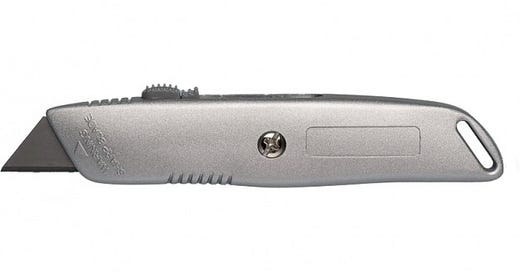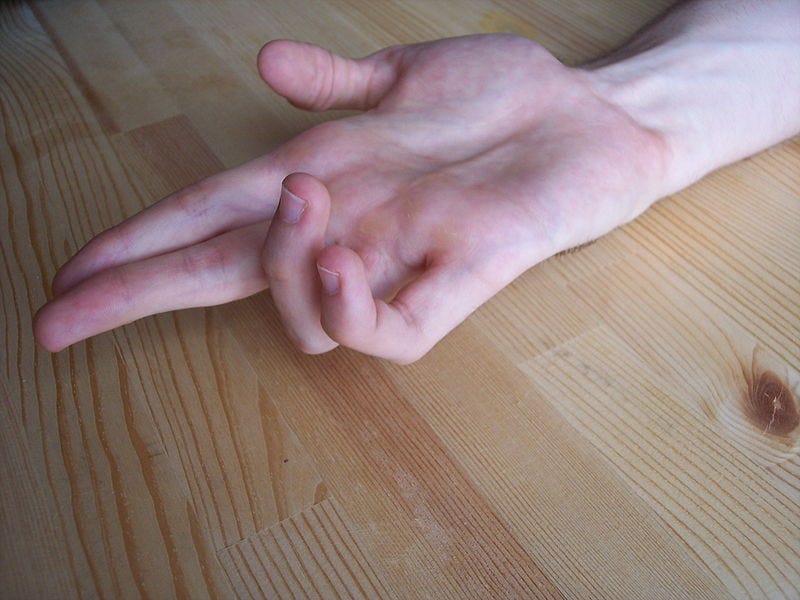Warning: This article has bloody pictures and video.
You’re working in the garage.
A box of [whatever] is on your table, ready to be opened.
You grab a box cutter and start cutting the tape.
Your hand slips.
You cut your other hand, the one that was holding the box steady.
Blood immediately starts welling up.
What do you do?
Hands are VERY complicated
We use our hands constantly to interact with the world.
They are a stupidly complicated system of pulleys and muscles.
It’s complicated enough that some doctors just do hand surgery and nothing else.
If a hand gets damaged in just the wrong way, it can be disabling.
There is very little you can do on your own to fix that in a SHTF situation.
But there are basic steps everyone should know.
My goal for you in this email is to be able to learn basic steps of wound care and to recognize when you need help with an injured hand.
This is not all-inclusive. Think of it as a general guide to “what can go wrong”.
How It Hurts
The most immediately dangerous thing you can cut is a blood vessel.
You have three types.
They are, in order of danger:
Arteries
Veins
Capillaries
It’s not important to remember the names.
It is important to recognize and act on how quickly the blood is coming out.
If enough blood is coming out to steadily hit the floor (examples 1 and 3 in the video), you need immediate help.
Apply firm pressure with a clean dressing and get help.
If you’re not bleeding out, that’s good.
The cut could still be bad.
Under your skin you have muscles, nerves, and bones.
Muscles move things. Tendons attach muscles to bones.
Cutting a muscle or a tendon can cause the fingers to not move, or to only move weakly.
If unrepaired, these can be disabling.
Usually we (general doctors) send these to hand surgeons.
This patient has a cut tendon. They are trying to bend the ring finger back into the palm but can’t.
Nerves give signals to muscles and bring sensation back to the brain.
Cut nerves can cause the same movement problems as cut tendons or muscles.
Cut nerves can also cause altered feeling or lack of feeling (“numbness”, “pins and needles”).
These can also be disabling and are also usually sent to surgeons.
This patient has damage to the ulnar nerve and is trying to straighten their ring and pinky fingers but can’t.
Bones provide structure and are where tendons attach.
This patient has an open fracture, or broken bone exposed through a cut.
Free to join with access to all content, past and future.
What To Do
If gushing blood, get help/call 911.
Apply pressure and do not let up until told to.
If not, immediately apply direct pressure with a clean dressing for 10 minutes.
If bleeding doesn’t stop, get help.
If bleeding stops, wash the wound with soap and water for a couple minutes.
Tap water is just as effective at cleaning as sterile water.
Wash dirt and visible debris out of the wound. Get water running into it and out.
Soap up the surrounding skin. Try not to get soap in the wound.
It might be a little irritating but not the end of the world (ha).
If you get a little soap in it, just rinse it out.
If it bleeds again with washing, reapply pressure with a new dressing once you’re done washing.
In general, get help at this point if:
It’s still bleeding every time you let up on pressure.
You can’t feel or move a part of your hand.
Something foreign is still stuck in the wound (dirt? glass?)
The cut is from something biting you or you punching someone.
You see anything deeper than skin.
You broke a bone.
How To Prep For It
You need to have a basic first aid kit.
Most commercial kits will have gloves, tape, gauze, nonstick dressing, and bandages.
(paid link)
Most of them have the same stuff in them.
Keep it in an easy to reach location.
Hard to grab something off the top shelf while you’re bleeding everywhere.
Make sure every member of your home knows where it is and can access it.
Quiz
You cut your wrist with a clean knife while making dinner. It’s pulsing blood steadily onto your cutting board. You should:
Burn it shut on the hot pan.
Apply direct pressure and call for help.
Put peroxide on it.
Tie off your arm with butcher’s twine.
You cut your middle finger with a clean knife while opening an Amazon package. It’s bleeding but you control it. What’s the next step to take?
Put peroxide on it.
Put triple antibiotic on it.
Wash it with soap and water for a few minutes.
Put vodka on it.
You’ve cleaned the wound from #2 appropriately and it still isn’t bleeding, but you can’t bend your index finger in towards your palm. You should:
Shrug it off, it’ll get better.
Seek help.
What’s the first step when you think someone might have CO poisoning?
Gather important documents.
Open a window.
Call 911.
Evacuate everyone outside.
Take home points
Hands are complicated.
Lots can go wrong and injuries can easily be disabling. Fortunately, most cuts are not.
If SHTF and you cut something important, there is little you can do beyond the basics.
Recognize and act on major bleeding first. Apply direct pressure for 10 minutes.
Washing simple cuts with soap and water is the most important thing you can do to lower infection.
Think of deeper injury (nerve, muscle) if fingers aren’t moving or sensation is off.
Get a basic first aid kit.
Answer key
b.
Burning wounds shut drastically raises infection and tissue damage. Peroxide actually does more harm than good and isn’t recommended (kills skin cells and slows healing). Butcher’s twine is too thin to use as a tourniquet and will cause damage.
c.
You need to wash it first and remove any surface bacteria or debris that got in the cut.
b.
You probably cut a tendon in this case. Get help ASAP.
d.
Evacuate.
Free subscriptions get access to all content, past and present.
If you would like to support the page, consider leaving a donation on Ko-fi.















If application of pressure does not stop bleeding, and a tourniquet is available, what should be the decision making process for tourniquet application vs continuing the efforts to stop the bleeding with pressure? How the decisions on the tourniquet application be affected if the medical help needed for a safe removal of tourniquet is hours away? days away? weeks away? not expected to be available at all?
Great post, Doc! Yes--hands ARE stupidly complicated. Ask me how I know that:
...Dupuytren contracture surgery aficionado. Caused by a few drops of Viking blood somewhere down the hereditary line.